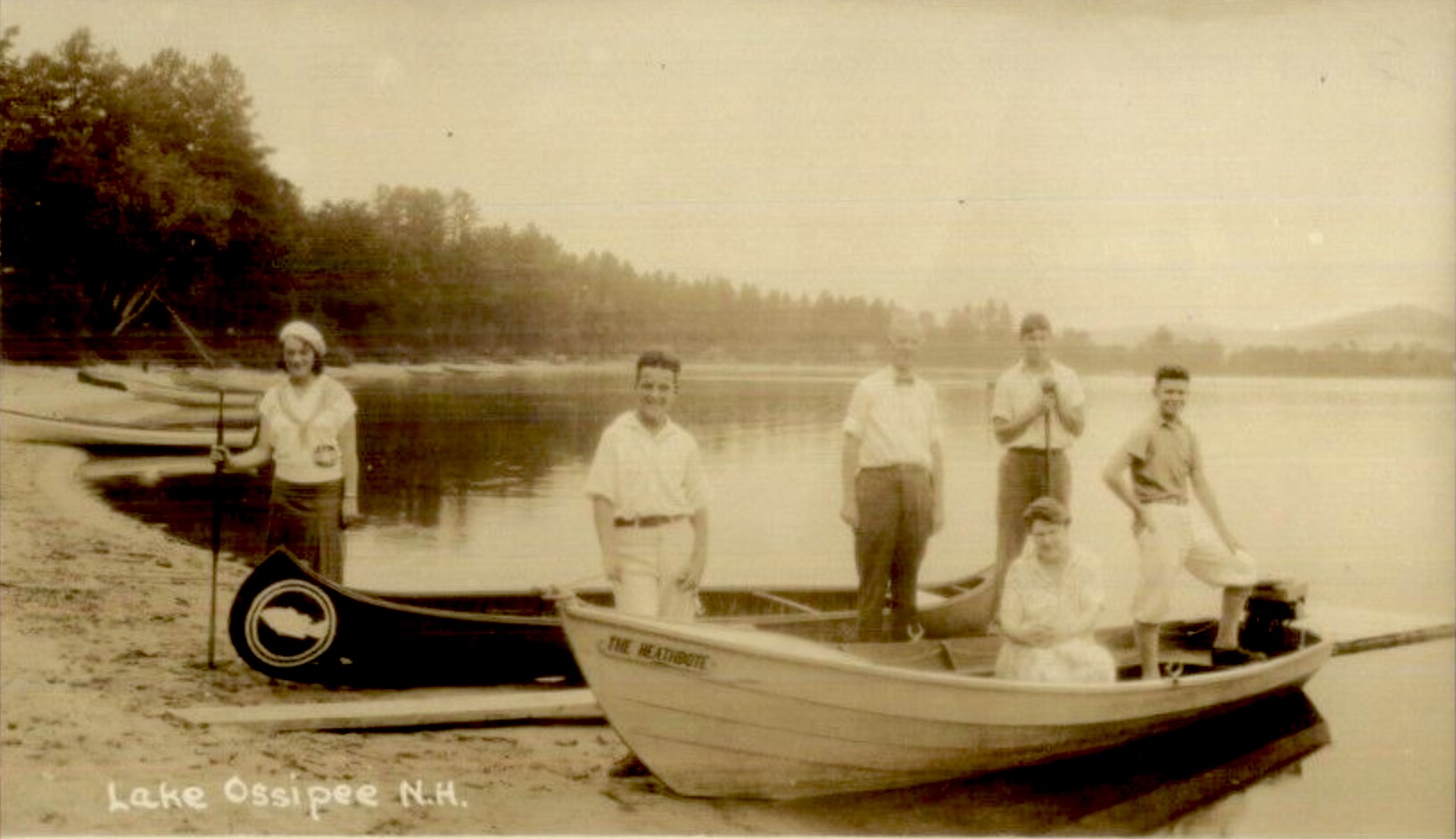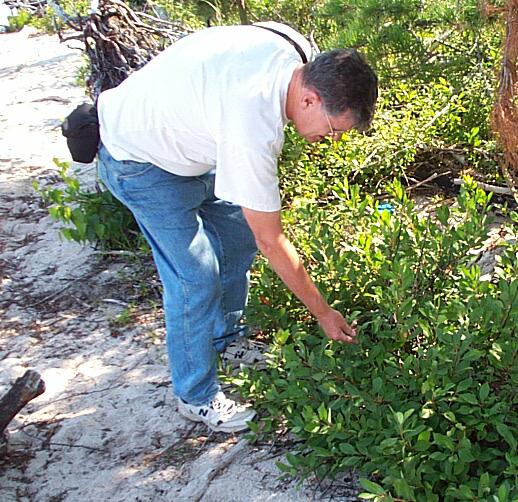From the Archives: A Public Beach in a Natural Area
Introduction
Ossipee Lake Natural Area has always drawn boaters. Set apart from everyone and everything, the wild, undeveloped stretch of land west of the Long Sands residential community has gorgeous mountain views and a shoreline with shallow water and a sandy bottom. Rumors about quicksand and ghosts add to its mystique.
Boaters made it a playground as the lake was developed for summer cottages and family resorts in the 1940s and ’50s, and their number grew after a second building wave brought condos and campgrounds in the 1980s.
In 1993, the legislature’s decision to mandate unlimited no-cost boat access to state lakes through unstaffed public ramps marked the end of several promising state initiatives to establish benchmarks for responsible levels of boat traffic to protect the quality of recreation and the environment.
By the end of the 1990s, as many as 3,000 boaters could be found at the Natural Area on holiday weekends. Tents, lawn chairs and portable grills dotted the beach, and there was trash, loud music, human excrement, unleashed dogs and open fires.
The property had become a public nuisance. Not just to abutting property owners, but to local police and Marine Patrol officers, who viewed the combination of large crowds, drinking and a remote location as potential trouble.
Biologists who studied the Natural Area had a different set of concerns. Boaters were unknowingly grinding the property’s unique environmental assets into oblivion, killing rare plants and destroying natural communities that are found there and nowhere else.
Everyone agreed something needed to be done, but year after year nothing changed. As the summer of 2000 approached, the Natural Area was in an environmental death spiral. How it was brought back from the brink is a story worth retelling.
Part 1: The Beginning
Picture the lake a century ago. In the early 1900s, the Natural Area was part of a huge parcel of undeveloped land running from the Ossipee River through Leavitt Bay and Broad Bay and on to Pine River.

Post card, likely from the 1920s, shows the lake prior to being extensively developed for cottages, children’s camps and family resorts. Alliance Collection
For years this giant land buffer protected the water supply for a succession of water power companies. But the profitability of water power declined as cheaper sources came to market, and by the end of the 1930s the last water power company closed shop and put its land on the market.
The Developers
Most of the undeveloped land was purchased by White & Sawyer, an Ossipee real estate development firm. From the 1940s into the 1960s, the company developed and sold hundreds of shorefront lots for seasonal camps and cottages, including the land where the Long Sands residential community is today. Left untouched, however, were 400 acres of rough terrain and dense wetlands next to Long Sands.
In the late 1960s the partners decided to sell that acreage to the State of New Hampshire. The state paid $320,000 and agreed to a covenant that the property be used solely for education or recreation.
What the state thought it might do with the land is lost to time. But from the start it was clear it lacked a plan to manage it while it considered the options. An orphan among state properties, its stewardship fell to the Department of Resources and Economic Development, known as DRED.
The Biologists
At the time of the state’s purchase of the property, Barre Hellquist was a graduate biology student at the University of New Hampshire who worked during summers at Deer Cove Lodge, a popular family resort on the lake. On his days off he would canoe from his parents’ cottage to the Natural Area to document the site for his dissertation.
What he found there was eye-opening. Peat mats extended into the lake from the shore through soft, multi-colored sands. Along the shoreline were plants with poetic names like Mermaid Weed, Virginia Beauty and Euthamia.
Most of what he documented was unusual, and some of it was rare. Plus, by growing together the plants formed unique plant communities that Hellquist had never seen.

Biologist Barre Hellquist was the first to publish articles about the Natural Area’s uniqueness. Alliance Photo
After he published his findings, other biologists took note. One of them was Dan Sperduto, who in 1984 wrote for the University of Vermont that the Natural Area had the largest collection of rare plants found in New Hampshire’s “sandy pondshore” ecosystems, and contained an “inland beach strand community” of a type not known to exist anywhere else.
More than a decade would pass before Sperduto was able to return to the site, this time on behalf of DRED’s Natural Heritage Bureau, the state’s custodian of the property.
Sperduto reported that the unique environmental assets he had previously written about were in “a steep decline” from damage by boaters, and he called on DRED and local officials to “make a more concerted effort” to balance preservation and recreation.
But nothing happened, and another decade would pass before the Natural Heritage Bureau returned. In a 2003 report, the researchers said recreation by boaters and erosion from high water had wiped out or severely degraded four rare plant species and the rare coastal sand plain pondshore natural communities.
In addition to before-and-after pictures of plant destruction, the report contained photos of litter, human waste, fire pits and vandalized signs. A canoe was shown padlocked to a tree, and there was a storage bin filled with beach chairs and grills hidden in the woods.
Appealing to DRED’s leaders, the researchers said controlling recreation and implementing an “immediate restoration plan” was the only hope of preventing the loss of the remaining rare plants. But, once again, DRED did nothing.
DRED
Consider the state agency that was DRED. For years it was an umbrella organization for four important state government functions. One recruited new business to the state, while another managed state parks for recreation. A third function focused on attracting tourists, and a fourth oversaw state-owned forests and lands. Each function had an executive leader who reported to DRED’s Commissioner.
In theory, DRED’s structure provided a single marketing platform to attract people and commerce to the state by leveraging its scenic beauty and quality of life. In reality, it was a portfolio of competing interests and priorities led by a succession of political appointees plucked from wildly different backgrounds.
In March, 2004, Republican Governor Craig Benson tapped career hotel executive Sean O’Kane to become DRED’s commissioner, replacing George Bald, who was appointed by the previous governor, Democrat Jeanne Shaheen.
At the time of his recruitment, O’Kane was general manager of the Center of New Hampshire Holiday Inn, described in a DRED press release as “the largest convention hotel north of Boston.”
The appointment of O’Kane at DRED barely made a news ripple on the lake, where property owners and town officials were just beginning to realize that they, and not the state, were going to have to pay to control the lake’s growing number of milfoil infestations.
But it wasn’t long before O’Kane made a splash. Seven months into his new job, the former hotelier shook hands with State Representative and Ossipee Selectman Harry Merrow on an agreement for DRED to lease part of the Natural Area to Ossipee for a town beach for $1 per year.
It was handshake that would roil the lake community for the next four years.
Next: Ossipee officials line up voter support for a Natural Area beach.

Best article I have read on this site! I will definitely support OLA!
Wow. I love the cliff hanger … and half way through the article, I spent 30 min googling everything about Ossipee Lake. Looking forward to Part II.
Excellent report David and a great beginning of what is still to come! Can’t wait to read more.
I will surely forward your series to our neighbors not so much a reminder of all the attention to detail needed to preserve our Lake under growing pressures of activities but as historic facts which clearly shows stewardship is the means of preservation.